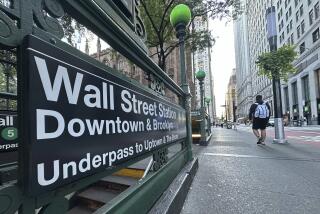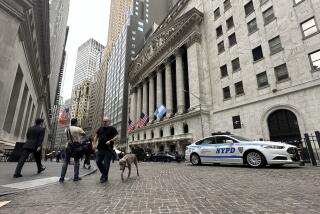Fed provides liftoff; stocks fly
Tuesday’s big rally on Wall Street has investors hoping the end is near -- in a good way, that is.
The Dow Jones industrial average rocketed 3.6%, its biggest one-day gain in five years, on news of the Federal Reserve’s latest move to shore up the nation’s financial system. The rally, which extended to other major market benchmarks, raised the possibility that stocks may be nearing the bottom of a slide that began last fall.
“This is the formula that investors have been waiting for,” A.C. Moore, chief investment strategist with Dunvegan Associates in Santa Barbara, said of the Fed’s action.
The central bank, under pressure to break the logjam in the credit markets, said it would lend as much as $200 billion in Treasury securities to banks and other financial institutions and would accept troubled debt, including slumping mortgage-backed securities, as collateral.
The move should increase investor confidence by making it less likely that bad debt related to the meltdown in the housing industry will sink a major bank or Wall Street firm, analysts said. Rumors have circulated in recent weeks about potential cash squeezes at big firms, including brokerage Bear Stearns Cos. and mortgage giant Fannie Mae.
Moreover, the Fed is moving in concert with central banks in Europe and Canada, which pledged to inject billions into their financial systems.
But Moore and others cautioned that past attempts by the Fed to shore up U.S. financial markets -- and investor sentiment -- since the credit crunch began last year have brought only temporary relief to stocks.
“It’s a short-term confidence booster for the market, but we’ve had several of these head fakes recently,” said Paul Hickey, co-founder of Bespoke Investment Group. “Putting it in perspective, it’s a big day, but we’re pretty much right where we were Friday morning.”
The stock market has been on a downward slope since October as the collapsing housing market, high oil prices, a nationwide credit crunch and worries of a recession put investors in a selling mood.
Before Tuesday, major market benchmarks such as the Dow and the Nasdaq composite index were either in bear market territory or very close to it, despite a series of interest rate cuts and other moves by the Fed.
Even with Tuesday’s rally, the Dow is more than 2,000 points, or 14%, below its all-time closing high of 14,164.53, reached Oct. 9. A bear market is usually defined as at least a 20% drop by major indexes from recent highs.
The Fed’s latest move should make banks and other institutions more comfortable about owning mortgage-backed securities, which in turn should loosen up lending to home buyers, said Kevin Marder, president of Marder Investment Advisors in L.A.
“Up until now, it’s been a game of hot potato -- nobody wants to hold them because the prices are going down almost every day,” he said. “This should be looked at as a first step. Not the be-all, end-all panacea, but certainly a noteworthy first step.”
Skeptics aren’t ready to concede even that. Housing prices are falling nationally for the first time since the Depression and the amount of bad debt in the hands of banks and other firms is still unclear, said Steven Romick, a partner and fund manager at First Pacific Advisors in Los Angeles.
“It’s only a stay of execution,” Romick said. “It gives them some time to work through their problems, but it doesn’t solve their problems.
“We believe this euphoria is temporary.”
On Tuesday, the Dow jumped 416.66 points to 12,156.81 and the Standard & Poor’s 500 index jumped 3.7% to 1,320.65.
The tech-heavy Nasdaq climbed 4% to 2,255.76.
The percentage gains for the Dow and Nasdaq were the biggest since the early days of the U.S. invasion of Iraq in March 2003. The S&P; had its sharpest one-day gain since October 2002.
Shares of lenders and brokerages surged, with the S&P; financial index climbing 7.4%. Citigroup gained 9%, adding $1.80 to $21.49, and troubled mortgage lender Countrywide Financial of Calabasas jumped 17%, rising 75 cents to $5.11.
All but one of the 30 Dow stocks rose, with energy giants Exxon Mobil and Chevron, construction equipment maker Caterpillar and financial services firm American Express leading the way. Only Boeing, which recently lost a major defense contract competition, was down.
The fact that the Fed was working with Europe strengthened the dollar, which rose against the euro and the yen. The greenback had fallen to record lows against the euro in recent months as the Fed cut interest rates to bolster the U.S. economy while European bankers held their rates steady.
“The coordinated effort with the European central banks is important,” Moore said. “It suggests some stability for the dollar.”
Although the slipping dollar has been a boon for U.S. exporters, it has helped push oil prices to record levels because crude is priced in the U.S. currency. That has contributed to inflation worries and made investors less receptive to the Fed’s recent rate cuts.
Yields on Treasury securities rose sharply as investors shifted money into stocks from the perceived safety of government obligations. The yield on the 10-year Treasury note climbed to 3.6% from 3.45% late Monday.
And oil rose despite the stronger dollar, adding 85 cents to a record $108.75 a barrel.
--
More to Read
Inside the business of entertainment
The Wide Shot brings you news, analysis and insights on everything from streaming wars to production — and what it all means for the future.
You may occasionally receive promotional content from the Los Angeles Times.










